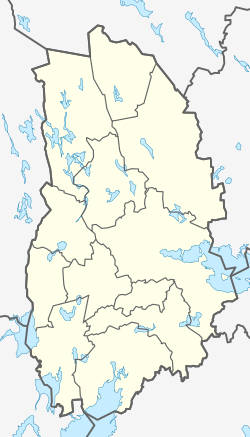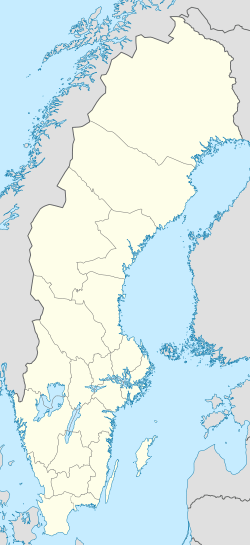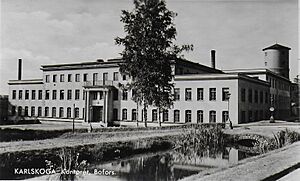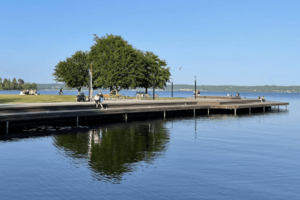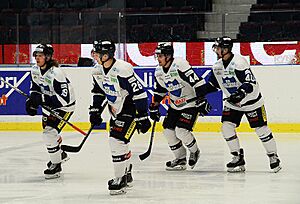Karlskoga facts for kids
Quick facts for kids
Karlskoga
|
|
|---|---|
|
Björkborn Manor
Karlskoga Church
Karlskoga Hundred Savings Bank
Circus Kiosk
Karlskoga Art Gallery
|
|
| Nickname(s):
Alfred Nobel's Karlskoga
|
|
| Country | |
| Province | Värmland |
| County | Örebro County |
| Municipality | Karlskoga Municipality |
| Named for | Charles IX of Sweden |
| Area | |
| • Total | 27.33 km2 (10.55 sq mi) |
| Population
(2018)
|
|
| • Total | 27,562 |
| • Density | 991/km2 (2,570/sq mi) |
| Time zone | UTC+1 (CET) |
| • Summer (DST) | UTC+2 (CEST) |
| Website | http://www.karlskoga.se |
Karlskoga is a town in Sweden. It is the main town of Karlskoga Municipality. You can find it in Örebro County, about 45 kilometers (28 miles) west of Örebro.
Karlskoga is located on the northern shore of Lake Möckeln. Two rivers, Timsälven and Svartälven, flow through the city. There's also a special hill called Rävåsen. It's a nature reserve right next to the city center.
The area around Karlskoga has many forests and hills. This made it a good place for industries like ironwork, not just farming.
Karlskoga grew up around the company Bofors. This company makes weapons. In 1970, almost 10,000 people worked there. Many jobs in the arms industry helped Karlskoga's population grow a lot. Today, Karlskoga is still important for the arms industry. But its economy also includes other types of businesses.
Karlskoga is home to the Björkborn Manor. This is where Alfred Nobel lived. Because he lived here, his will was processed in Karlskoga. This led to the creation of the famous Nobel Prize. Other important places include the Nobel Laboratory, the Karlskoga Church, and the Bofors Hotel.
Contents
What's in a Name?
Karlskoga was first called Möckelns bodar. This name came from small houses near Lake Möckeln. The name "Karlskoga" was first used in 1591. It comes from King Charles IX. The word skog means "woods" in Swedish. So, it means "Charles's woods."
A Look at Karlskoga's Past
Early Days
In the early 1500s, Karlskoga and its surroundings had very few people. More people started to move there in the 1580s. King Charles IX encouraged people to settle in the area.
People from other parts of Sweden, especially Finns, moved in. They used a farming method called slash-and-burn. This means they would cut down and burn trees to clear land for farming. Other groups also came, like Huguenots from France. They were skilled metalsmiths.
The church area of Karlskoga was set up in 1586. A small wooden church was built soon after. It was small because the population had grown quickly.
The Industrial Age
In the 1600s, many small ironworks were built. These were places where iron was made. Eight water-powered hammers were used to make bar iron. This is how Björkborn Works and Bofors Works started. Sigrid Ekehielm became a leader in this industry. She owned both ironworks.
By the 1860s, most of these ironworks were still running. But the Bofors ironworks became the most important one. In 1871, Bofors made more iron than any other factory in Sweden.
The town of Karlskoga grew around Bofors. In the late 1800s, Bofors changed from making iron to making cannons. In the 1900s, it became a bigger defense company. Bofors officially became a company in 1873. Since the 1880s, it has focused on making cannons.
Alfred Nobel's Connection

The most famous owner of Bofors was Alfred Nobel. He owned the company from 1894 until he died in 1896.
Nobel helped change Bofors into a modern cannon and chemical industry company. He lived at the manor house Björkborn during the summers of 1894–1896.
Alfred Nobel died in Italy. But his official home was considered to be Björkborn in Karlskoga. This was his last home in Sweden. Because of this, his famous will was officially registered here. This will led to the creation of the Nobel Prize.
The 1900s and Today
In 1940, Karlskoga officially became a "city." This term doesn't have a special legal meaning anymore. Now, it just means the built-up area.
For most of the 1900s, Karlskoga grew as a "company town" for Bofors. This meant many people worked for Bofors. But in recent years, the number of jobs in the defense industry has gone down. This has caused some challenges for the town. For example, in 1980, Bofors had 8,500 workers. By 1998, this number was only 2,600.
In the early 2000s, about 1,000 apartments were taken down. This was because fewer people lived in the town. The population went down to 29,600. But in the 2010s, the population started to grow again.
In 2023, a magazine called Fokus said Karlskoga was the fifteenth best municipality to live in Sweden.
Where is Karlskoga?
Karlskoga is in a low mountain range called Kilsbergen. This area separates two Swedish regions, Närke and Värmland. Historically, these areas were not very rich. Many people from this area moved to North America in the late 1800s. For example, Stockholm, Wisconsin in the USA was started by people from Karlskoga in 1854.
Karlskoga borders other towns and areas. These include Hällefors and Storfors to the north. To the east is Lekeberg. Degerfors and Lake Möckeln are to the south. And to the west is Kristinehamn.
Different Areas of Town
Karlskoga has many neighborhoods. They show its history as a "company town." Some areas like Baggängen and Ekeby have buildings from the "Million Programme." This was a plan to build many homes in Sweden.
The Rosendal neighborhood is special for its old homes. It was planned by the Bofors Works. This area is important for its cultural heritage.
People in Karlskoga
Karlskoga's population grew a lot when the Bofors company expanded. This growth continued until the 1970s. After that, the population went down quite a bit. But in the last few years, it has started to recover. Karlskoga is the second largest town in Örebro County.
About 16.5% of the people in Karlskoga were born in other countries. This is similar to other towns in Sweden.
People from Other Countries
In the 1580s, a few Finns settled in the area that is now Karlskoga. By 1649, many farms were run by Finns.
In 2017, the largest groups of people born outside Sweden were from Finland, Syria, and Somalia.
Languages Spoken
In 2012, Karlskoga Municipality became an official Finnish-speaking area. This means that Finnish is recognized and supported there.
Beliefs and Churches
Many different religious groups are in Karlskoga. The Church of Sweden has several churches. The oldest is the Karlskoga Church, built in the 1600s. Other churches include Karlberg Church and Rävåsen Church.
There are also several free churches. The Swedish Pentecostal Movement has its own church. Jehovah's Witnesses have their Kingdom Hall. A Baptist church was started in 1884. A Catholic church, St. George's, was started in 1956.
Karlskoga has several cemeteries. The oldest one was probably made when Karlskoga Church was built. Skogskyrkogården, or "The Woodland Cemetery," opened in 1908. The Eastern Cemetery opened in the 1940s.
Karlskoga's Economy
Making Things
Karlskoga is an important place for making weapons and medicines. Many big international companies have offices or factories here. These include parts of Bharat Forge, BAE Systems, Saab AB (like SAAB Bofors Dynamics), Nammo, Cambrex Corporation, Recipharm, Moelven Industrier, and Eurenco.
Culture and Fun
Books and Writers
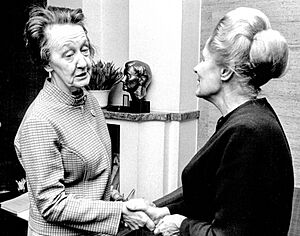
Karlskoga has connections to famous writers. Maja Ekelöf wrote a popular book called Rapport från en skurhink in 1970. Nobel laureate Selma Lagerlöf also spent time in Karlskoga. Her novel "Charlotte Löwensköld" describes places in Karlskoga.
Also, children's literature writers Anders Jacobsson and Sören Olsson are linked to Karlskoga. They used the town as inspiration for places and characters in their "Bert Diaries" series. The fictional town of Öreskoga in their books is based on Karlskoga.
News and Radio
Karlskoga Tidning-Kuriren is Karlskoga's main and only daily newspaper. It was created in 2020 when two older newspapers joined together. There is also a local radio station called Cityradion.
Sports in Karlskoga
Karlskoga has several sports arenas. Nobelhallen is the biggest. It even hosted a world junior ice hockey championship in 1979. Karlskoga is home to the ice hockey team BIK Karlskoga. They play in HockeyAllsvenskan, which is the second-highest league in Swedish ice hockey.
Karlskoga is also known for diving and canoeing. Clubs like Bofors SHK and Bofors KK are here. Famous Olympic champions from Karlskoga include Ulrika Knape in diving, and Agneta Andersson and Maria Haglund in canoeing.
There is also a football (soccer) team called KB Karlskoga FF. And a women's soccer team, Rävåsen IK.
Famous People from Karlskoga
Arts
- Monica Forsberg, singer, songwriter and actress
Sports
- Agneta Andersson, sprint canoer, Olympic gold medalist
- Bengt-Åke Gustafsson, former NHL player
- Anna Karlsson, sprint canoer
- Maria Haglund, sprint canoer, Olympic bronze medalist
- Johan Motin, NHL player
- Ulrika Knape, diver, winner of one gold and two silver Olympic medals
Others
- Peter Arvai, co-founder of Prezi
- Alfred Nobel. He lived at the Björkborn Manor house. This is why his will was processed in Karlskoga, leading to the Nobel Prizes.
- Stina Swartling, writer
Karlskoga Around the World
Twin Towns
Karlskoga has "twin towns" or "sister cities" in other countries. This means they have special friendly connections.
- Suspended Twin Towns
Other Partnerships
Karlskoga also works with other cities and regions:
 Birmingham, England
Birmingham, England Bremen, Germany
Bremen, Germany Irvine, Scotland
Irvine, Scotland Jordanów, Poland
Jordanów, Poland Łódź, Poland
Łódź, Poland Lüchow-Dannenberg, Germany
Lüchow-Dannenberg, Germany Rheinfelden, Germany
Rheinfelden, Germany Strathclyde, Scotland
Strathclyde, Scotland Unter Franken, Germany
Unter Franken, Germany Vale of Glamorgan, Wales
Vale of Glamorgan, Wales Vitry-le-François, France
Vitry-le-François, France Watford, England
Watford, England
See also
 In Spanish: Karlskoga para niños
In Spanish: Karlskoga para niños







